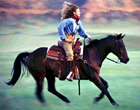

Have a horse easily back off a trailer
Hello... I have a fairly new SSH gelding that WILL not back out of the trailer... I have a 2 horse slant load and can loosen the divider and turn him around but it is close... It is a step down trailer and not too high... He will stay in there for a week if I don't turn him around... He backs well on the ground, and fair under saddle... His fear seems to be the drop, I guess... I have tried half loading him and backing him out several times.. He just got sour and wouldn't load at all... but normally he loads well and on his own... Thanks for any ideas.. By the way, makes no difference whether in front or last stall.
Cindi
Hi Cindi,
Having a good back up cue on the ground is vital to having a horse easily back off a trailer. Sounds like your horse is already backing well on the ground. I would now work on having him back off of small ledges out in the open such as backing off a sidewalk curb, a small platform or bridge, etc. Back him up and down hills, through ditches, over ground poles, everywhere!
Backing is a constructive exercise for the horse anyway. Backing builds your leadership position along with respect for your space. It helps the horse understand how to shift his weight back, lighten the shoulders and work from the haunches which is a more coordinated and athletic way for the horse to work in general. Backing strengthens the hocks, stifles and muscles of the haunches and lower back and brings the back feet under him which is valuable for collection when riding.
I would do all this backing using a good rope halter so he doesn't learn to lean into or push on a strap halter. I use a side-to-side wiggle of the lead rope to teach a backing cue from the feel of the halter noseband moving side-to-side.
The next step after you have backed and backed him all over the place for a few weeks is to put him in long drive lines. Attach the lines to the sides of the rope halter and drive him from behind as you hold a line in each hand. Along with driving him forward and turning, you will also stop and back him from the drive lines using a slight, steady pressure from both hands. Keep him looking straight away from you with you staying directly behind him at a safe distance of course. You can keep him straight by holding pressure on the drive line opposite of the direction he wants to turn, just the same as if you were riding. (For a complete demonstration and explanation of long line driving please see our "Foundation Training" DVD available on our web site at http://www.eddabney.com/video.htm). As soon as he makes a step backward release the pressure. Continue this until he is backing well from the drive lines then begin driving him to obstacles and terrain features to have him back off ledges, bridges, hills, small ditch banks, etc. using the drive lines and standing behind him. When he is doing all this very well with no resistance then you are ready to load him in the trailer.
Load him normally then try to just back him out very slowly and gradually using your normal lead rope cue. Don't rush him. Give him plenty of time to work it out. He may get to the edge of the trailer and need to step down and back up with just his back feet or even just one back foot several times before he actually backs completely off the trailer. Offer him lots of release, praise and rubbing for every small step backward. If he will not back off using your normal cue then hook up your drive lines to the sides of the rope halter and stand behind him outside the trailer. Then very gently and slowly begin to apply a very small amount of pressure to both lines asking him to take a step back. Be sure and release pressure with every step. Don't be in a hurry. Bring your lunch and be prepared to stay all day if necessary. Take the time it takes to do it right without causing him to panic. It's ok to have someone help you keep him straight by standing quietly at his head holding the lead rope when you first ask him to back off the trailer using the drive lines. If you go too fast or apply too much pressure you could cause him to rare up in the trailer. If you've spent plenty of time (days or weeks) doing your preparation work as described above then he should back off the trailer with no problem. As with most things in life, there are no "quick fix shortcuts". Remember, good preparation is the key to success.
Enjoy the Journey,

Ed Dabney is an internationally acclaimed clinician, presenting horsemanship and riding clinics all over the US and in Europe. In 2007, Ed was named Champion of the East Coast Trainer Challenge Series by Equine Extravaganza. Ed was honored to have been selected by the University of Georgia to teach their senior level Young Horse Training course.
His training articles have appeared in many major national magazines. Ed produces instructional videos and the “Gentle Horsemanship” TV program which has been seen on RFD-TV.
Ed's blending of natural horsemanship and classical equitation has made an indelible mark with students all across the United States and now also in Europe, drawing the attention of serious riders searching for the lightest touch and the deepest connection with their horses irrespective of breed or discipline.


